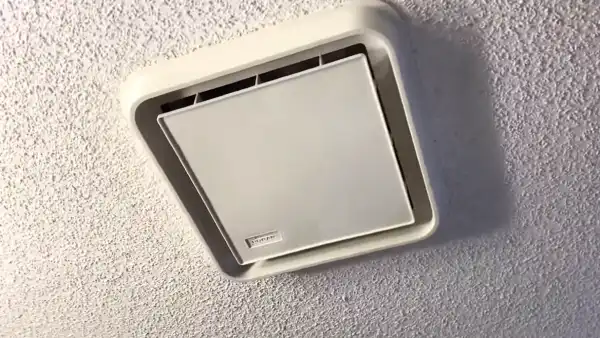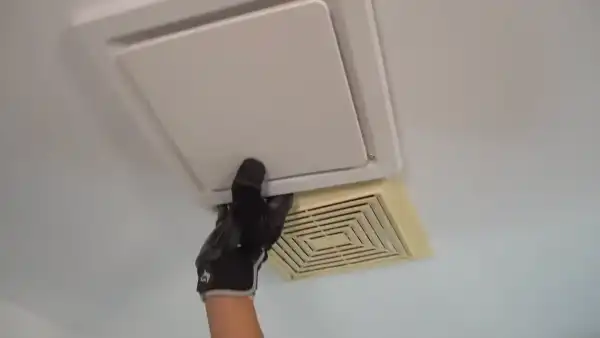Last Updated on October 18, 2023
Moisture is common in bathrooms, especially after a hot shower or a relaxing bath. The presence of moisture can lead to the growth of mold, mildew, and bacteria, making the bathroom environment unpleasant and unhealthy.
To combat this issue, it is common practice to install bathroom fans. While there are ductless alternatives available to remove humidity, do these bathroom fans remove moisture effectively?
Ductless bathroom fans can remove a very small amount of moisture. But they can’t remove 100% moisture from the air as efficiently as their ducted counterparts. Ductless bathroom fans are good at controlling odors and improving air circulation.
We will discuss why ductless bathroom fans do not effectively remove moisture from bathrooms and how to control moisture without ductless fans.
Do Ductless Bathroom Fans Remove Moisture: Factors That Make Them Ineffective

Ductless bathroom fans are ineffective at moisture removal for several reasons. The following are among them:
- No ducting
- Activated charcoal filters
1. No Ducting
You should know that ductless bathroom fans cannot remove moisture by venting outside. While traditional exhaust fans with ducting systems, ductless fans lack the means to channel moist air out of the bathroom.
Instead, they simply recirculate the air back into the room, which can lead to increased humidity levels and condensation buildup. This inability to effectively remove moisture is a significant drawback of ductless bathroom fans.
2. Activated Charcoal Filters
Ductless bathroom fans rely on activated charcoal filters to address odors and impurities. While these filters are effective at capturing some airborne particles and odors, they cannot trap water droplets or reduce humidity levels significantly.
Water droplets from showers and baths are relatively heavy and can settle on surfaces, causing damage and discoloration over time. Activated charcoal filters do not have the capacity to trap or absorb these water droplets, rendering them ineffective in reducing bathroom moisture levels.
As a result, even if your ductless fan has a high-quality activated charcoal filter, it will still fail to address humidity issues, leaving your bathroom vulnerable to structural damage and mold growth.
How Can You Control Moisture in Bathrooms Without Ductless Fans?
To effectively control moisture in your bathroom without relying on ductless fans, you can implement several options. They’re:
1. Install Exhaust Fan
You should consider installing a traditional bathroom exhaust fan with external venting to remove moisture and odors from your bathroom effectively. These fans are highly efficient in controlling the humidity level and preventing mold and mildew growth.
By expelling moist air directly outside, they eliminate the risk of moisture getting trapped within the walls or ceiling, which can lead to costly damage over time.
These fans also help to improve indoor air quality by removing unpleasant odors, such as those caused by cooking or cleaning products.
2. Use Dehumidifier
Consider using a portable dehumidifier in the bathroom to remove excess moisture from the air efficiently. In humid climates, such as those found in coastal areas or tropical regions, high humidity levels can be a common problem in bathrooms.
This excess moisture can lead to issues like mold growth and musty odors. A portable dehumidifier works to eliminate this problem. These devices draw in moist air and cool it down, causing the moisture to condense and collect in a water tank or drain hose.
3. Natural Ventilation
Natural ventilation is a cost-effective and efficient way to remove moisture from the bathroom. Opening windows and doors can help circulate fresh air in the bathroom, reducing humidity levels and preventing moisture buildup.
When you open windows or doors, fresh air enters the space while humid air is expelled outside. This process helps to dilute and replace moist air with drier air from outside.
Additionally, natural ventilation allows for better airflow, aiding in the evaporation of water droplets on surfaces.
Please note that this method works best when outdoor conditions are drier than indoor conditions, such as during warm seasons or in arid climates.
4. Shower Curtains and Mats
Using shower curtains containing water and mats that absorb excess moisture helps prevent the spread of water across the bathroom.
When you take a shower, water splashes onto the curtain instead of spreading all over the floor. This containment reduces the risk of slipping and falling in wet areas.
Additionally, mats placed strategically near the shower or bathtub further absorb any leftover moisture, preventing it from seeping into other parts of the bathroom.
Using these simple measures, you can effectively control and minimize moisture buildup in your bathroom. This is especially important as excessive moisture can lead to mold growth and damage to your walls and floors.
How long do ductless bathroom fans last?

In general, ductless bathroom fans last around 10 years, but their effectiveness may decrease over time due to smell removal.
As the fan ages, its ability to adequately ventilate the bathroom may be compromised. This can lead to a buildup of moisture, which in turn can cause issues such as mold and mildew growth or unpleasant odors.
Regular maintenance will help extend the lifespan of ductless bathroom fans and maintain their performance.
This includes cleaning or replacing charcoal filters regularly and ensuring that the fan is free from any debris or obstructions.
Choosing a high-quality fan from a reputable brand can also contribute to its longevity and overall effectiveness in removing moisture and odors from your bathroom.
Is it better to vent the bathroom fan through the wall or roof?
It is generally better to vent a bathroom exhaust fan through the roof rather than through a wall.
Venting through the roof helps avoid potential moisture infiltration issues into the attic space.
When a bathroom fan is vented through a wall, there’s a risk that the moist air it expels can be drawn into the attic through nearby soffit vents. This potentially leads to moisture-related problems like mold and insulation damage.
Venting through the roof minimizes the chances of these issues and ensures the moisture is safely expelled outside. As a result, your home’s structure is less likely to be damaged.
Embrace the Right Solution for a Fresh and Moisture-Free Bathroom
Ductless bathroom fans do somewhat remove moisture but aren’t as effective as traditional vented fans.
The absence of ducting and reliance on activated charcoal filters limits their ability to address the pressing issue of bathroom humidity.
To combat moisture-related problems, it’s advisable to opt for traditional exhaust fans with external venting, which efficiently expel humid air outside and safeguard your bathroom from mold, mildew, and structural damage.
Additionally, you can explore alternatives such as dehumidifiers, natural ventilation, and smart bathroom practices to keep your bathroom environment fresh and moisture-free.

